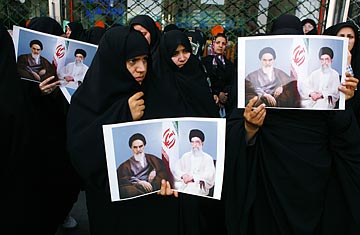
Thousands of people attend a state-organized rally in a square in central Tehran on June 16, 2009
Tens of thousands of Iranians march across central Tehran to Freedom Square angrily demanding the overthrow of the nation's leader in favor of an unlikely political leader.
The scene describes Iran today, but it could be a snapshot of the Islamic revolution 30 years ago. Then, as now, the protest gradually picked up steam before exploding into a mass movement. Both events were fueled by a widespread sense of injustice, inflamed by official arrogance and shared by state-of-the-art communications technology.
And, like a recurring nightmare, the current uprising has caught U.S. policymakers by surprise.
"We get Iran wrong with a startling degree of consistency," says Suzanne Maloney, senior fellow at the Saban Center for Middle East Policy. "We definitely got it wrong this time. I say that for everyone in government and for everyone out of government."
Intelligence failures are more understandable today than they were in 1979. At that time, Washington stubbornly stood behind the regime of secular and autocratic Mohammad Reza Shah Pahlavi, despite the rebirth of religious fundamentalism among millions of Iranians and their yearning for an obscure Muslim cleric living in exile: Ayatullah Ruhollah Khomeini. U.S. military, diplomatic and intelligence officers blanketed Tehran but ignored the gathering storm. It was a massive blunder. Khomeini swept into power and transformed Middle East politics and alliances. His supporters seized the American compound and its occupants, an act that has frozen bilateral relations in a state of hostility ever since.
U.S. intelligence has suffered from the 30-year divorce. The emergence of Iran as a rival to the U.S. and its interests in the region has led to more government and academic analysis today than ever — but mostly from afar. Widely held views on Tehran's political factionalization have inspired tough U.S. policy toward hard-liners, a policy driven as much by a desire to encourage moderate forces. But recent developments have called into question some of the assumptions about the nation's leaders and their ability to control events.
